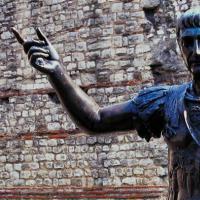Peter Paul Rubens: biography and best works
He was not shy about the "triumph of the flesh", magnificent forms that adorned his immortal canvases. He depicted mythological characters brightly, juicy, playfully, they were almost earthly creatures, rejoicing in life. His works adorn our Hermitage, the legendary Louvre, the Munich Alte Pinakothek.
Biography of Peter Paul Rubens
Italian apprenticeship
Peter Paul Rubens, a Fleming who was born in Germany (it was there that the “disgraced” father of the future painter Jan was forced to hide), managed to return to the homeland of his ancestors only in 1587 (at the age of ten). Jan Rubens died in a foreign land, Maria arrived in Antwerp, already a widow with children.
Peter took his first drawing lessons from Dutch painters, known only for the fact that it was from them that the great artist learned the basics. But an in-depth study of the basics of craftsmanship took place with Rubens already in Italy, where the High Renaissance flourished. He lived in this sunny country for 8 years, starting in 1600. He worked as a court painter with the Duke of Gonzago. And he himself absorbed both the luxury of Italian landscapes and the ingenious techniques of the geniuses of the Renaissance.

In Rome, Peter Paul is delighted with the works of Raphael, da Vinci and Michelangelo, in Venice he creates copies of the paintings of the famous Veronese and Titian. In addition, he fulfills the diplomatic missions of his patron (he was then the Duke of Mantua).
Patronage of the Infanta
Thus, it is no longer a green youth who returns to his native land, but an accomplished artist. He was treated kindly by Infanta Isabella (then ruling in Flanders) and her husband Albert. It was a period of truce between powerful Spain and Holland, so that Flanders was recovering from bloody battles. And the Spaniard Isabella was a good viceroy, understood what her goals were, favored the representatives of art, and Rubens became the favorite among them.

The works of that period dealt mainly with religious themes. Many created by the painter and portraits of royalty.
It is interesting that the characters of mythology on the canvases of the Fleming became beautiful and cheerful people full of health. Catholicism did not welcome such receptions, but the patronage of the powerful of this world helped Rubens avoid friction with the church.
The best works of Peter Paul Rubens
Eroticism is imbued with the works "Bacchanalia" and "The Abduction of the Daughters of Leucippus".

The painting “The Union of Earth and Water” is very well known among us, replicated by many reproductions and copies (the original is kept in the St. Petersburg Hermitage).

Dynamic and very colorful are the "Battle of the Amazons" and "The Return of Diana from the Hunt".

The most famous museum in St. Petersburg also houses the painting "Perseus and Andromeda", which is considered the pinnacle of the work of Peter Paul Rubens (if we take exactly the ancient theme). Magnificent work of art!

The creative scope of the painter and his diligence amazed his contemporaries. He worked on portraits and hunting scenes with the same ease with which he paints paintings on religious themes or landscapes. He brought up a galaxy of students in his own workshop - they helped him in his work, participating in the largest orders.
Such, for example, was a series of panels for the Queen of France, Marie de Medici. 21 scenes previously discussed with a high-born customer were supposed to decorate the Luxembourg Palace. Allegories and ancient gods are successfully combined in these works with costumes and surroundings contemporary to the artist.
In the same 20s of the 17th century, well-known portraits were born, including the Infanta Isabella's Maid Keeper stored in the Hermitage.

The image of his dead wife is captured by him in "Self-portrait with Isabella Brant". In 1626, when she died, the world seemed to collapse for the master and his two children. He left Antwerp and took up secret diplomatic missions for the Infanta. But he could not live without creativity, and again devoted the last decade of his life only to him.

Back to life
Rural idylls Rubens depicted in "Peasant Dance", "Kermess", "Landscape with a Rainbow" and "Return of the Reapers".

Someone will say that these works are reminiscent of the masterpieces of Pieter Brueghel. But the author himself would not object to such a comparison: he never hesitated to adopt the best techniques of his colleagues.
He remarried the daughter of a friend, Elena Furman, a girl much younger than the artist (at the time of the marriage, she was only 16). She became his model and muse.
We see her features in "Bathsheba" and "Andromeda", the later masterpieces of the Fleming.

Elena smiles at us from the canvas “Fur Coat”, she is also one of the “Three Graces”.
Gout prevented Rubens from creating, she gnawed at him more and more. At the age of 62, the genius died. He was buried with almost royal honors.


